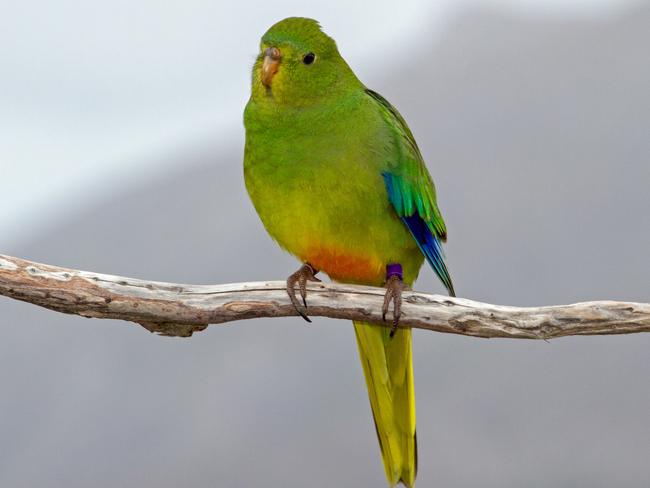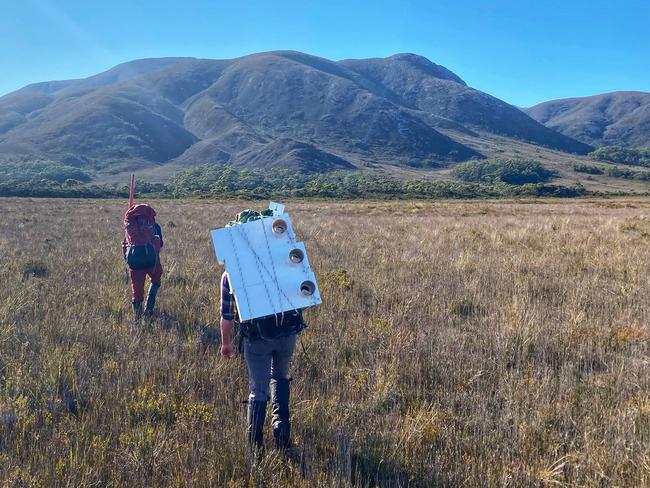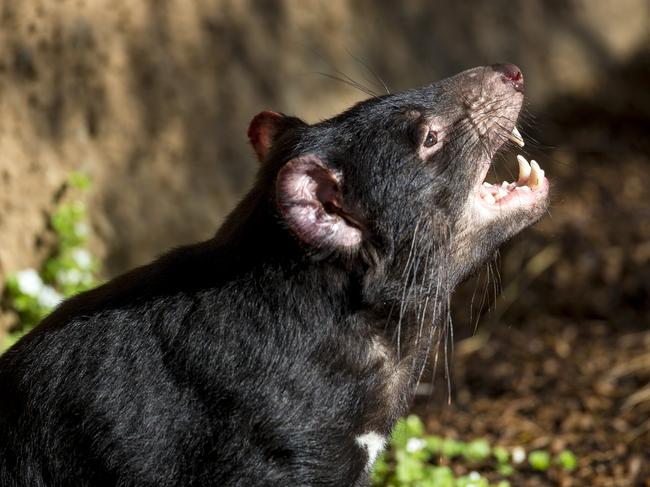Orange-bellied parrot flies back from the brink
Five years ago, biologists were left watching as a critically endangered parrot was “going extinct right in front of us”, but now those same scientists are grinning from ear to ear.

Tasmania
Don't miss out on the headlines from Tasmania. Followed categories will be added to My News.
FIVE years ago, biologist Shannon Troy was in tears in remote bush in Tasmania’s South-West.
Working in the World Heritage Area at Melaleuca on the recovery program for the orange-bellied parrot, Dr Troy was sad and emotional because the massive efforts over many years to save the critically endangered parrot species from extinction in the wild appeared to be failing.
It was the summer of 2015-16 and Dr Troy had been eagerly checking nesting sites for new eggs and chicks – site after site after site brought bad news: no birds.
At the end of counting that breeding season, there were only 17 parrots left in the wild, and just four were female and therefore capable of producing chicks.
“I was standing under a tree crying because they seemed to be going extinct right in front of us,” Dr Troy, wildlife biologist for the Orange-bellied Parrot Tasmanian Program, explained.

The lightweight 20cm-long parrot species had been the subject of a huge effort by scientists such as Dr Troy to bring it back from the brink, but those good intentions – worth millions of dollars and paid for by federal and state governments and groups such as BirdLife Australia – were not succeeding.
Installing nesting boxes, tagging, monitoring, protecting habitat and introducing captive-bred parrots into the wild flock in the hope they would breed in the wild were doing little to stem the species’ spiral to oblivion.
“They were scary times,” Dr Troy said. “At one point we got down to three breeding pairs.”

Five years on, however, and Dr Troy is grinning from ear to ear because after a couple of very productive breeding seasons, the species is in better health in population terms since counting began, with a whopping 192 parrots setting off on the annual migration from their Melaleuca breeding grounds at the end of summer, bound for interstate wetlands.
And this week the first of those parrots was identified to have arrived in Victoria.
“It’s a relief, I’m not so much excited,” she said. “It’s just a huge relief.”

When the parrots return to breed in Tassie at the end of the year, Dr Troy said more captive-bred birds would be released into the wild and it was hoped the population would spread out across the Melaleuca breeding range.
Last summer a few birds used nesting boxes 5km from Melaleuca and Dr Troy said she hoped that trend to spread out would continue as numbers increased.
Between 500 and 600 orange bellied parrots have been bred in cages to ensure the species’ survival in captivity and to provide a backstop of new stock that can be released in the wild.

BUTTONGRASS BURN-OFF
BUTTONGRASS plains in the world heritage wilderness, where orange-bellied parrots graze, need to be burnt regularly to provide food for the endangered birds, Dr Troy said.
She said when the Melaleuca grasslands were not burnt, buttongrass dominated and became too thick to allow the growth of tiny plants, such as lemon-scented boronia, that provide nutrients for the parrots.
“The parrots don’t actually eat the buttongrass, they eat the plants that grow in-between and which are stimulated to seed by fire,” Dr Troy said.
The Melaleuca landscape is thought to have been created by Tasmanian Aborigines regularly burning over thousands of years, known as firestick farming.
These bushfires are low intensity and not anywhere near as hot or destructive as forestry regeneration burns, which favour the regrowth of eucalypt species for commercial return. Dr Troy is pushing for regular burn-offs in the area to continue the revival of the orange-bellied parrots.
Mixed record on species survival
SCIENTISTS are relatively confident the Tasmanian devil will not become extinct any time soon because there are now enough being bred in captivity to ensure the species’ survival.
And there is rising confidence the devil is not headed for extinction in the wild either.
This is a vast improvement in the prognosis for the species from 20 years ago when an infectious cancer first began to decimate local populations.
The rapid rate at which devils were perishing as the ugly face cancer spread across the island had many seriously worried about its survival as a species.
However, a multimillion-dollar recovery program appears to have turned the fortunes of the iconic Tasmanian carnivorous marsupial.

Since British colonisation, about 100 of Australia’s unique flora and fauna species have gone extinct.
Tasmania’s poor reputation for extinctions was cemented early, with the demise of two large and symbolic animals, the Tasmanian emu and thylacine — the two animals are on Tasmania’s coat of arms and were conspicuous absentees on the world stage.
Another big Tasmanian animal has been struggling in recent years, Australia’s largest bird of prey, the Tasmanian wedge-tailed eagle subspecies.
It faces continued threat from shooters who ignore its protected status, powerline electrocutions, wind-turbine strikes, vehicle collisions and habitat destruction and disturbance, which have a big impact on breeding success.

Since federal laws were introduced in 1999, the list of threatened species and ecosystems in Australia has grown by more than a third.
There are 14 species of handfish, all found only in southeast Australia, with most found in Tasmania and nowhere else on the planet.
Last year, the International Union for Conservation of Nature updated their Red List of Threatened Species to include all 14 species. Three are critically endangered — the spotted handfish, the red handfish and Ziebell’s handfish.
The big threats to handfishes are habitat loss and habitat degradation.

As urban development spreads, the quality of water in and around reefs is undermined by pollution, siltation and invasive species, which result in imbalances in the ecosystem.
Add the stress of climate change, including rising water temperatures, fishing and other human disturbances, and the quirky handfish species face a hard road ahead.
Originally published as Orange-bellied parrot flies back from the brink


